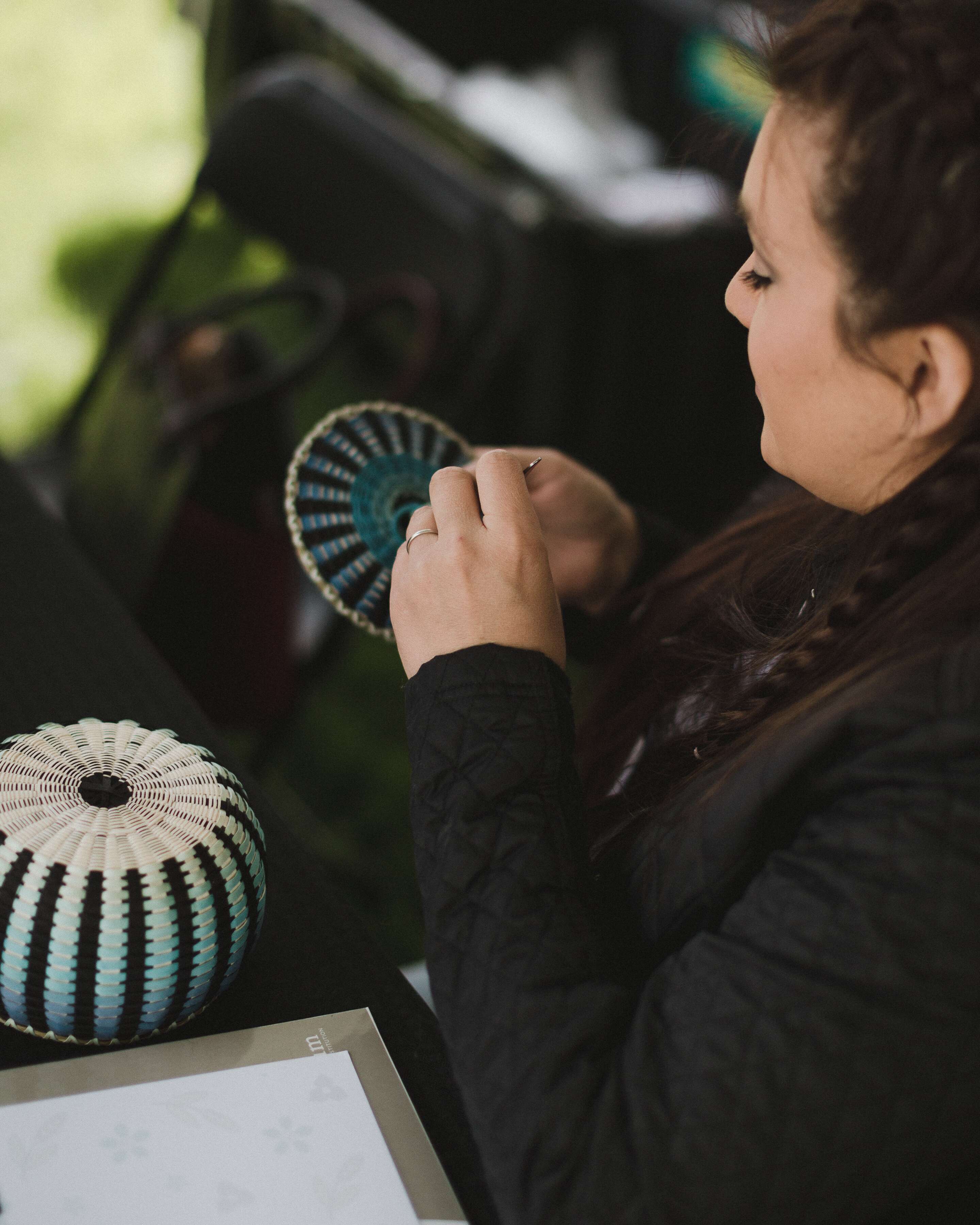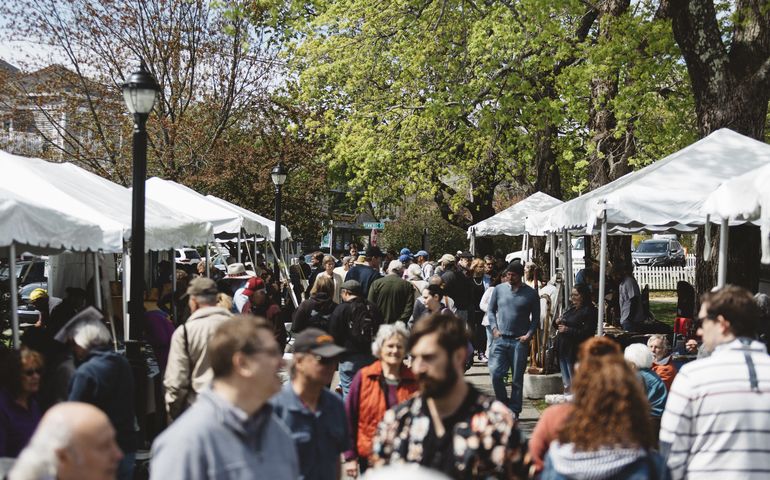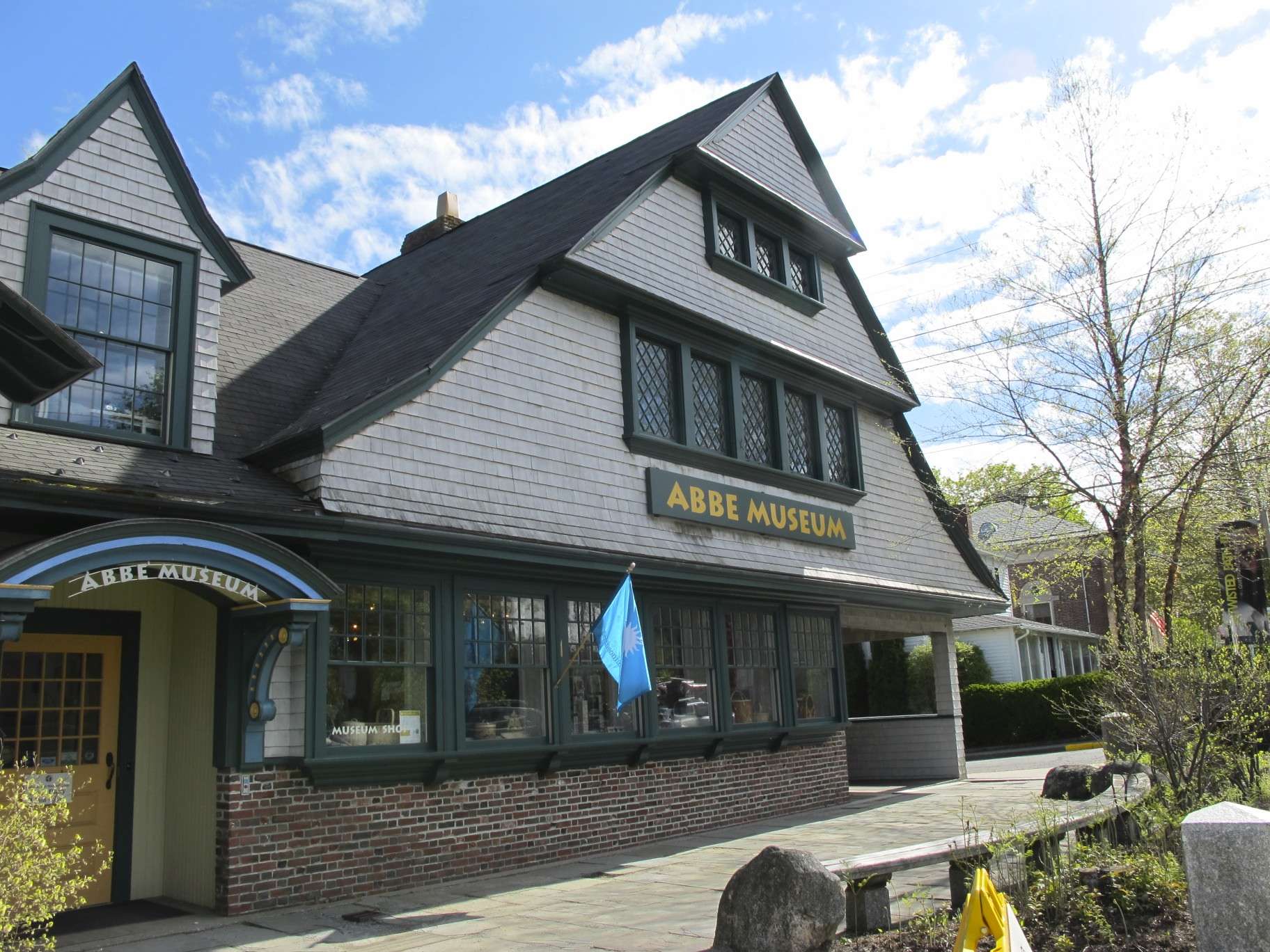
Bar Harbor’s Indian Market expected to double economic impact in one year
 Courtesy / H.B. Mertz
The inaugural Abbe Museum Indian Market brought 5,000 visitors to the Bar Harbor Village Green.
Courtesy / H.B. Mertz
The inaugural Abbe Museum Indian Market brought 5,000 visitors to the Bar Harbor Village Green.
The second annual Abbe Museum Indian Market is expected to nearly double its economic impact in the Bar Harbor area.
Approximately 75 Native American artists and performers from over 40 nations will attend the 2nd Abbe Museum Indian Market, scheduled this weekend, May 17-19, in downtown Bar Harbor. The event will include a fashion show, film festival, storytelling, dancing, music and other performers.
A juried Indian art show is relatively unknown in the Northeast, according to an Abbe Museum news release.
“By creating this event, the museum will shine a bright light on Wabanaki artists and deepen the economic impact of art making for tribal communities,” the release said. “Markets like this one help artists to work full-time and make a living through art. Markets also help revitalize remnant art forms and make room for innovation.”
“We’re experiencing tremendous growth in year two,” Stefanie Joy Muscat, Abbe Museum’s director of advancement, told Mainebiz. “We have 40% more artists coming this year.”
The economic benefit to Bar Harbor from last year’s market was $250,000. This year it is expected to be around $500,000.
The inaugural market, last year, showcased 55 artists. This year’s market will feature over 75 artists, from as far as the Pacific Northwest.
That includes 20 Wabanaki artists from Maine and Atlantic Canada.
“The artists draw inspiration from tribal identity and culture as seen through a unique lens,” Muscat said. “One thing we’re particularly excited about is to bring this diversity of arts and culture to Maine.”
Native showcase
The Abbe and the Maine Indian Basketmakers Alliance have hosted a smaller event called the Native American Festival, now in its 26th year and scheduled for July 6. That event features Wabanaki artists only. “Wabanaki,” meaning "People of the Dawnland,” is the collective term for Maine’s four Indian tribes: the Maliseet, Micmac, Penobscot and Passamaquoddy.

The new Indian Market is an expansion on the idea, because the juried event will showcase Native artists from around the nation, said Muscat.
The market is based on models like the Heard Museum Guild Indian Fair & Market in Phoenix, Ariz., and the Santa Fe Indian Market in New Mexico.
The Heard Museum Indian Fair dates back to 1959, today features more than 600 Native artists, and is the second largest market of its kind in the country. The Santa Fe Indian Market, dating back to 1922, is the largest juried Native arts show in the world, attracting over 100,000 visitors from all over the world and 1,000 artists from 200-plus federally recognized tribes from the U.S. and Canada.
Award-winning Wabanaki artists like Jeremy Frey, Theresa Secord, Emma Soctomah, Geo Neptune, Gabriel Frey and Sarah Sockbeson travel out West each year to participate in those and other Indian Arts marketplaces, and have repeatedly taken top prizes, said Muscat.
“We were hearing from Wabanaki artist who travel to these shows that they were garnering attention but there wasn’t anything in the Northeast quite like it,” she said. “That was part of the impetus for our Indian Market.”
Leading up to the first Indian Market last year, Muscat and her team consulted with organizers of the larger markets and volunteered there in order to understand how they were set up. Volunteers from the Heard Museum Guild traveled to Bar Harbor to provide volunteer assistance, she said.
Exceeding expectations
“We became a top-flight show right out of the gate,” she added. “Last year, we had tremendous response” with 5,000 attendees. “We’re expecting that number to increase substantially this year, given the amount of national and regional coverage we’ve received.”
The increase in the number of featured artists is largely due to word of mouth, she said.
“Lots of artists last year spoke highly about their experience in Maine,” she said. “We’re a smaller market than the big markets out west, but that affords us the opportunity for visitors to have intimate encounters with the artists and talk with them about their work. Some of the bigger places don’t afford that opportunity, becaue they have hundreds of artists.”
Last year’s visitor numbers and sales exceeded expectations, she said.
“We had artists who were sold out within the first half-hour,” she said. “So this year we’ve already had visitors calling to make sure they will get here early enough to be able to see the pieces.” That includes Native American art collectors as well as people from the New England and New York region who regularly attend Indian markets out west and plan to travel to Bar Harbor this weekend, she said.
Launching the tourist season
The timing of the market pushes up the start of Bar Harbor’s tourist season, which is typically considered to kick off on Memorial Day weekend.
“This has pushed the start of the tourist season in Bar Harbor to a week earlier,” Muscat said. Anecdotally, she said, she’s heard from lodging owners who said they were receiving bookings this weekend because of the market. The event also benefits area restaurants, shops and tour companies, she said.
“We know from last year that restaurants were full, that shops were selling merchandise,” she said. “Some Bar Harbor shop owners said it’s like having a second Memorial Day weekend.”
The economic benefit to Bar Harbor due to last year’s market was $250,000.
“This year we expect to edge up to $500,000,” she said.

In addition, there’s immediate economic benefit to the artists, she noted. Not only does the market provide an additional opportunity for them to sell their work; there’s also a ripple effect in their home communities.
“They go back to their community and need supplies, they need an accountant, they need to set up some IT, so they reach out to others in their community for that,” she said. “It’s a ripple effect.”
Overall, she said, traditional and contemporary arts are “a critical lifeblood” to Native communities.
“They’re not just creating something to sell,” she said. “These art forms are rooted in generations of traditions and story-telling and family bonds and interconnectivity. In order for these communities to continue to thrive, it’s important for the arts to thrive as well.”
Aggressive marketing
As a nonprofit organization, Muscat said, the Abbe depends on corporate sponsors and in-kind support to fund the market, which costs around $150,000 to mount. The Abbe has spent about $5,500 on marketing the event, but has received nearly $30,000 of in-kind support through media sponsorship.
In addition, an aggressive marketing campaign has garnered media coverage that’s estimated to have reached one million people, she said.
Marketing for this year’s event began immediately after last year’s.
“We did a lot of national and international media, starting nearly a year ago,” she said. “We planted stories and purchased ads. Over the last nine months, I’ve been coming in closer to Bar Harbor. We got a great story in the Boston Globe that kicked off the regional marketing. Now local newspapers and radio stations are talking about it.”
Muscat credited Maine Public as a key state sponsor
“They’re providing fantastic coverage,” she said. “That’s the kind of thing that an organization our size can’t afford.” Key local sponsors include the Mount Desert Islander and Ellsworth American, which have provided coverage and an insert with an overrun to hand out to visitors, she said.
“So it’s old-fashioned PR work,” she said. As a result, “We have had to spend about one-quarter of what we spent last year on marketing, because we have a bigger media footprint this year.”
The market will take place at the Village Green in Bar Harbor, across from the Abbe Museum. The film festival will take place at Reel Pizza. The fashion show will take place at the Criterion Theatre. Both are in downtown Bar Harbor.
Saturday’s fashion show at The Criterion at 6 p.m. highlights the work of indigenous fashion designers who draw inspiration from their tribal identities to present their culture through a modern lens. This year’s designers include ACONAV Acoma Pueblo/Navajo, Ingrid Brooks (Mi’kmaq), Leslie Deer (Muskogee Nation of Oklahoma), Niio Perkins (Haudenosaunee) and Dawn Spears (Narragansett, Choctaw).
For the schedule and a list of participating artists and a preview of their work, visit abbemuseum.org/indianmarket.
Sponsors and funders include: Abbe Museum Wabanaki Art & Artists Giving Circle, Bangor International Airport, Bar Harbor Bed & Breakfast Association , Belvedere Fund (Maine Community Foundation), Betterment Fund, Canterbury Cottage, Cultural Attractions Magazine, Edward Jones, Elmina B. Sewall Foundation, Ellsworth American & Mt. Desert Islander, Irving Foundation, Maine Office of Tourism, Maine Public Broadcasting, Native American Art Magazine, New England Foundation for the Arts (NEFA), Reel Pizza Cinerama, SPACE Gallery Townsquare Media, Wallace Events, William Blair, Window Panes.
The mission of the Abbe Museum, Maine’s first and only Smithsonian affiliate, is to inspire learning about the Wabanaki Nations. With two locations – in downtown Bar Harbor and inside Acadia National Park at Sieur de Monts Spring – the Abbe works closely with the Wabanaki people to share their stories, history and culture with a broader audience. With a collection of over 70,000 archaeological, historic, and contemporary objects, the museum's collections conservation program is recognized nationally as a model for museums. The Abbe also holds the world’s largest and best-documented collection of Maine Native American basketry.










0 Comments